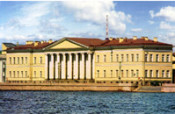
The first session of the Emperor Academy in St.-Petersburg took place
In 18th century in Russia as in other countries a great attention was paid to the development of fundamental and practical sciences. On January 13 (24), 1724 in the Senate building Peter I signed “the definition on the Academy”. On January 22 (February 2) the emperor approved the statute project on establishing the Academy of science and arts and the University under it composed by the tsar’s physician-in-ordinary L.L. Bluementrost. On January 28 (February 8), 1724 was published the Senate’s order on establishing the St.-Petersburg’s Academy of science.
The official grand opening day of the Emperor’s Academy of science is considered the day of December 27, 1725 (January 7, 1726) when Catherine I organized a state reception for academicians. On this day in the house of the disgraced baron P.P. Shafirov at Petersburg’s side in the presence of the government, court and clergy members took place the first grand academic session. The academicians Ya. German and G.B. Bulfinger speaking at the session noted that the Academy of science foundation in Russia was the greatest event of the time.
By the time of the Academy opening Russia did not have scholars prepared enough who could take the position of an academician. Therefore the staff of junior scientific assistants and the first academicians was included mostly the foreigners. Among the first academicians were such eminent scholars as the famous mathematician Daniil Bernully and one of the greatest mathematicians of the 18th century Leonard Ayler. However, soon the leading positions were taken by the scholars educated by the Academy of science itself. The first Russian junior scientific assistant was V.E. Adodurov, the first professor among natives of Russia was G.V. Rihman, the first Russian professors were M.V. Lomonosov and a poet V.K. Tredyakovsky. In the second half of the 18th century worked their way up naturalists and travelers S.P. Krasheninnikov, I.I. Lepehin, N.Ya. Ozerezkovsky, V.F. Zuev, mathematician S.K. Kotelnikov, astronomers N.I. Popov, S.Ya. Rumovsky, P.B. Inohodtsev, chemist Ya.D. Zaharov, mineralogist V.M. Severgin.
From the very beginning the Academy had not only theoretical but also practical objectives such as the development and dissemination of useful practical knowledge. At the same time the St.-Petersburg Academy of science unlike the West European ones had to become not only a research institution but also an educational one. The University and the gymnasium were attached to it. The Academy itself consisted of 3 classes: mathematics, physics and humanist. The class of mathematics included four departments: first one – of theoretical mathematics, second one – of astronomy, geography and navigation, third and fourth ones – of mechanics that Peter considered very important. The class of physics included four departments – physics (theoretic and experimental), anatomy, chemistry and botany. The class of humanist consisted of three departments: oratory and antiquities; antique and modern history; law, politics and ethics.
The emperor was considered the supreme head of the Academy. However the institution was allowed to elect its president for life or for the period of 1 year or six months. The Academy also had the right to elect its members. The state financing distinguished the St.-Petersburg Academy of science from the similar institutions of Europe.
Under the Academy of science were created a cabinet of curiosities, an observatory, a typography and later engraver’s chamber and other departments. The Academy had its own library where was published “St.-Petersburg Vedomosti”. Expeditions were a special field of the Academy’s activity. Astronomic, geodesic, geographic observations, fauna and flora, minerals and peoples’ ethnography were studied.
Lit.: Копелевич Ю. Х. Основание Петербургской академии наук. Л., 1977; Кудрявцев В. Академия наук и обществоведение // Обозреватель. 1999. № 6; Пекарский П. П. История Императорской Академии наук в Петербурге: в 2 т. СПб., 1870-1873; Тарасова М. Издания Российской Академии Наук [Электронный ресурс] // Ростовская электронная газета. 1999. 6 июля (№ 13 (19)).
Based on the Presidential Library’s materials:

